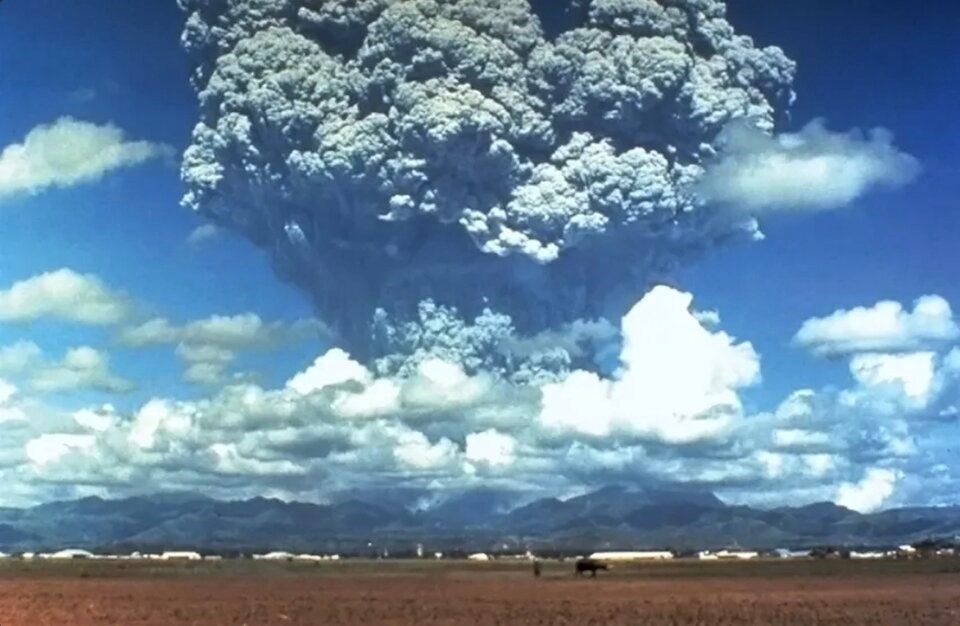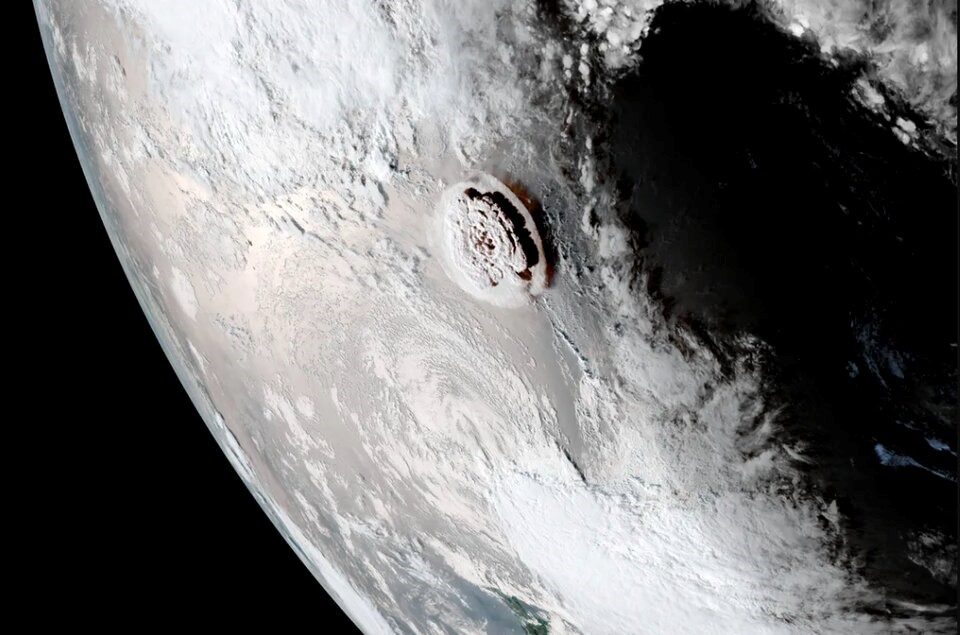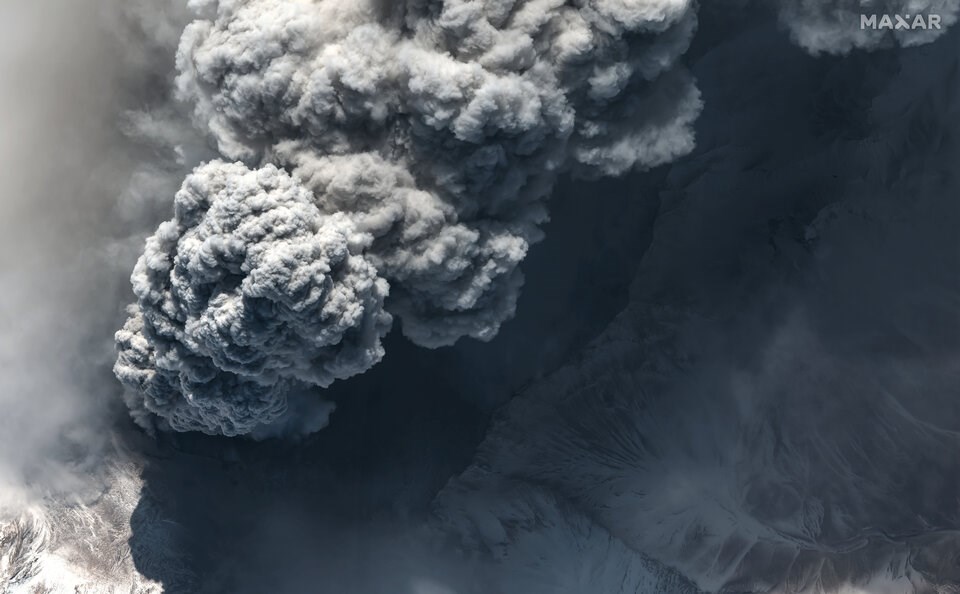In 1815, Mount Tambora blew its top, ejecting huge volumes of gas and ash into the upper atmosphere in the largest volcanic event in recorded history.
On the Indonesian island of Sumbawa, the initial eruption is thought to have killed up to 50,000 people. But the ash and gas it sent into the upper atmosphere travelled around the world, tinting sunsets red and triggering crop failures as far away as Northern Europe in what would become known as the “year without a summer.” By some estimates, another 50,000 people died in the resulting starvation.
In the years since, major eruptions have raised questions over how a super volcano would affect the world’s climate system. In 1991, the eruption of Mount Pinatubo was thought to have dropped global temperatures by more than half a degree.
Even Hollywood has entertained the role a super volcano could play in the end of the world. In the apocalyptic movie 2012, Woody Harrelson’s character welcomes the eruption of a super volcano at Yellowstone Park in a live radio broadcast.
“I’m watching the earth crumble before my eyes,” he says moments before getting crushed by a molten rock.
The risk a volcanic eruption would blot out the sun and precipitate cascading extinctions might not be as high as once thought, according to a new study published in the journal Nature Geoscience.
“Do they have the potential to cause mass extinction events or not? That's kind of the heart of the question,” said Johan Gilchrist, the lead author of the study who carried out the research as a Ph.D. candidate at the University of British Columbia.

The extinction potential of supervolcanoes has animated a number of theories of widespread societal collapse, including the fall of the Bronze Age Minoan civilization, which suddenly disappeared more than 2,000 years ago after the nearby Greek island of Santorini exploded in a catastrophic eruption.
“It’s classically been thought the bigger the eruption, the more intense the effect on climate — nearly a one-to-one relationship between eruption size and climate effects,” said Gilchrist.
But with scientists unable to witness Santorini's eruption, the volcanologist said it's not clear if its fallout had a serious effect on the global climate, or simply led to localized devastation.
To find answers, the UBC researcher and his colleagues began their search at the bottom of the Mediterranean.
Hot rock avalanches 'surf' into the ocean
In 2015, co-author Emily Hooft mapped out a vast pattern of submarine terraces ringing Santorini "like rice paddy fields in Thailand," as Gilchrist put it.
“When you look at the seafloor topography, you're like, 'Wait, this must be human-made,'” he said.
Back at UBC, the team of researchers built a prototype of the volcano to model eruptions similar to how engineers run model airplanes in a wind tunnel or model ships in a water tank.
One video from an experiment shows a sandy pink cloud erupting from jets inside a water tank. The artificial volcanic plume bursts upward, but instead of remaining high into the experimental chamber, the material settles into a billowing cloud shaped like a spinning top.
Gilchrist says the experiments confirmed large volcanic eruptions often produce hot rock avalanches that slam into the sea, "surfing" long distances across the surface of the water. Meanwhile, from the sky, a fountain of rock comes hailing back down, triggering tsunamis, and eventually settling into natural terraces on the sea floor.
The experiments showed the longer a big eruption lasts, the more frequent hot rock avalanches will pour out of the volcano. Locally, Gilchrist said his team’s research could have significant implications for anyone living within tens to hundreds of kilometres of an active volcano.
“If we've got all kinds of instruments around the volcano, we're getting all this data,” he said. “But then you need the theory for how the eruption actually behaves to then turn that data into real-time warnings and to inform evacuation procedures.”
Ejected volcanic material falling faster than once thought
In early 2022, the researchers were still months away from submitting their research into the historic eruption at Santorini when a “magma hammer” slammed molten rock into the base of the Hunga Tonga-Hunga Ha’apai underwater mountain — each impact carrying the force of a billion tonnes.
On Jan. 22, 2022, the most powerful natural explosion in a century echoed across the Pacific Ocean. The 15-megatonne volcanic explosion launched water vapour so high it touched space, according to scientists speaking at an American Geophysical Union fall meeting in Chicago nearly a year later. The resulting atmospheric explosion was heard 10,000 kilometres away in Alaska and is thought to be the biggest bang recorded by modern instruments.
Tsunami warnings were triggered around the Pacific Rim, including Vancouver Island and Juan de Fuca Strait. Waves as high as 45 metres crashed into some of Tonga’s nearby islands, yet few lives were lost. According to another study published last week, that appears largely a result of effective emergency planning, fortunate geography and a shallow-water “wave trap” that captured tsunamis for more than an hour before they could slam into population centres.

Global climate patterns also appear to have come through the eruption relatively unchanged.
To impact the planet's climate, a volcanic eruption has to have enough velocity to send ash and dust into the stratosphere, where the jet stream can pull the aerosols around the planet and block energy from the sun, said Gilchrist.
But even in the case of the immensely powerful Hunga Tongo eruption, it appears most of the hot rock and ash fell back to Earth relatively quickly without reaching the jet stream.
Imagine pointing a hose to the sky and putting your thumb over the nozzle. Pull your thumb from the hose and the high-pressured fountain of water will quickly subside. During large eruptions like that at Santorini or Hunga Tongo, the volcanic activity appeared to have quickly opened the volcanoes' vents, relieving subterranean pressure and preventing most of the gas and ash from reaching high enough speeds to hit the stratosphere.
In a similar pattern Gilchrist recorded in the UBC lab, 80 per cent of the ejected rock and ash blown from Hunga Tongo fell to the seafloor.
“Most of it falls back down to earth,” said Gilchrist. “And so basically, our research is showing why some of these very large explosive eruptions that we used to think would have a big climate effect, don’t.”
That’s not to say the eruption of supervolcanoes hasn't happened and won't happen again, cautioned Gilchrist. He points to the eruption of Mount Toba 73,000 years ago on the Indonesian island of Sumatra, which some think decimated life across Southeast Asia at the time, but likely had uneven effects on human populations in faraway continents like Africa.
“If Yellowstone were to erupt, it would still be a continental crisis for all of us in North America,” said the volcanologist.
Research could improve volcanic ash early warning systems
When it comes to big volcanoes, how much goes up and how much comes back down has implications for most living things on the planet.
Using weather radar and satellite imagery, Gilchrist says volcanologists are already starting to measure the velocity of the debris as it erupts out of volcanoes. As they fine-tune those measurements, researchers are taking a step closer to creating real-time warning systems that could forecast the effects of an eruption on global climate patterns, predict how and when falling debris would trigger tsunamis, and when to get people out of the way of hot rock avalanches.
But Gilchrist says the most immediate application of their research would be to help aviation navigate the kind of ash clouds that shut down flights over northern British Columbia last week following the eruption of Russia's Shiveluch Volcano thousands of kilometres away.
“We got to understand volcanoes because they’re such a huge threat to aviation,” he said.
“The aviation industry has a bunch of advisory centres constantly monitoring for volcanic eruptions, and right now, we're not very good.”



